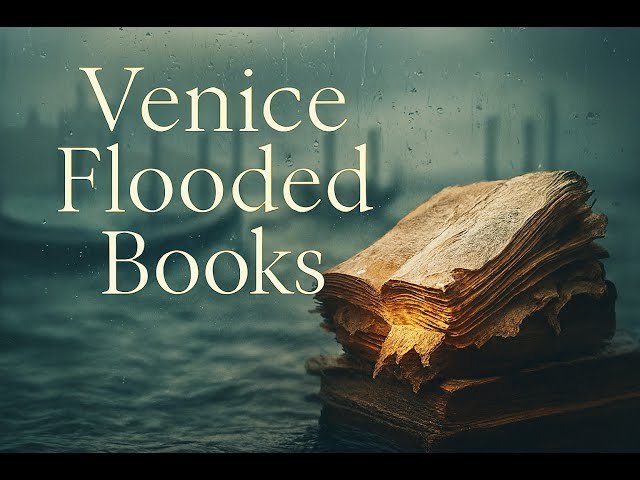Venice Floods 2019: A Night That Changed the City Forever
In November 2019, the Venice floods 2019 devastated the historic city, submerging nearly 85% of its streets and landmarks under water. A perfect storm of a full Moon, fierce winds, and a violent cyclone created the flooding, marking the second-worst disaster in Venice’s modern history after the catastrophic Acqua Granda of 1966. This calamity renewed global concern for the fragile future of the lagoon city.

Amid the chaos, photographer Patrizia Zelano embarked on a remarkable journey of recovery and remembrance. Her mission was not only to document the destruction but also to salvage what could still be saved — books that carried the essence of Venice’s history, art, and culture.
An Urgent Mission During the Venice Floods 2019
On the night of 12 November 2019, Zelano watched in disbelief as news footage revealed the rising tides consuming Venice. By dawn, she made a decision that would define her work — to head straight into the heart of the disaster. Leaving her home in Rimini, she drove for hours, then took a train into the flooded city, which was still under a state of emergency.
When she arrived, the streets were covered with water nearly half a meter deep. Wearing rubber boots, Zelano waded through Strada Nova, a main pedestrian route now transformed into a canal. She visited the home of a friend’s acquaintance, where the aftermath was overwhelming. “Objects, furniture, and books were scattered everywhere — soaked and ruined,” she later recalled.
Among the chaos, it was the books that captured her attention. Their pages, swollen with saltwater, appeared both fragile and resilient. One of them, so tightly sealed by silt and humidity, resembled an ancient artifact — “like an archaeological find from the Stone Age,” she said.
Saving the Soul of Venice
Realizing she needed to preserve more, Zelano contacted Lino Frizzo, a well-known Venetian bookseller who owns the shop Acqua Alta — aptly named “high water.” During those frantic days, Frizzo and his team were tirelessly trying to save what they could. Many of their books, however, were beyond repair. Zelano was given around 40 damaged volumes, many dating back to the early 1900s.

“These were not antique books by definition,” she explained, “but they were beautifully made — with fabric covers and ornate lettering. Even in decay, they carried a deep sense of dignity.” Among them was a red-covered poetry anthology that she called an “injured book,” symbolic of the wounded soul of Venice itself. Venice floods 2019
A Gondola Full of History
At 55, Zelano faced a daunting challenge — transporting these soaked, heavy relics across a flooded city. She placed them in large black plastic bags, but carrying them alone was nearly impossible. In a uniquely Venetian twist of fate, she persuaded a gondolier to help ferry her back to the train station.
“Some books disintegrated at my touch,” she remembered. “Their pages turned to lace, delicate yet destroyed.” One particularly fragile book had holes in its cover that resembled sea coral — a haunting reminder of the lagoon that had both given and taken life from the city.
Back in her studio, Zelano began photographing the damaged books under natural light. She didn’t open them. Instead, she let their shapes and textures speak for themselves. Each one became a symbol — of memory, fragility, and resilience.
From Water to Art: Photographing the Damaged Books
One of the rescued volumes was a Treccani encyclopedia from 1949, featuring an image of a Roman genie — a guardian spirit symbolizing protection. To Zelano, it felt almost prophetic. “It was as if this symbol of protection had survived to remind us that knowledge, too, must be safeguarded,” she said.
Another encyclopedia, dated 1951, had warped into shapes resembling ocean waves. It was a poignant reflection of the forces that had destroyed it. With her camera, Zelano sought to transform loss into art — an act of resistance through creation.

Her photographs highlight the intimate connection between Venice’s cultural heritage and its vulnerability to environmental change. As sea levels continue to rise — increasing by about 5.9mm annually according to NASA — the danger to the lagoon city grows. Compounded by land subsidence, which causes Venice to sink roughly 1.5mm a year, the future remains uncertain.
A Tribute to Culture and Memory
“These books are crying,” Zelano once said of her work. In one photograph, a drop of water still clings to the cover of an encyclopedia, symbolizing the tears of the city. For her, each image serves as both a eulogy and a celebration — a tribute to Venice’s enduring spirit.
She described arranging several books together, their pages resembling waves or the curves of heart shapes. “When we face personal or environmental storms,” she reflected, “we learn what truly matters — what must be saved.”
Among the books were encyclopedias of art history from 1978, containing reproductions of Canaletto’s paintings — the 18th-century artist famed for capturing Venice’s beauty. These volumes, warped and stained, echoed the same cityscapes that Canaletto once immortalized in oils. The irony was striking: Venice, long admired for its reflections in water, now risked being erased by it.
The Rising Challenge of Venice Floods
Venetians have long lived with acqua alta, the high tide that floods the city several times each year. However, the Venice floods 2019 were a stark warning that climate change and rising sea levels are amplifying these events.

While the MOSE flood defense system — a series of mobile barriers designed to protect the lagoon — has been partially effective, experts warn it may not be enough in the decades ahead. For locals, floods are now an inevitable part of life. Yet, in their resilience lies the same spirit that Zelano’s photographs capture — a determination to rebuild, remember, and resist.
Turning Destruction Into Hope
Zelano’s work, now recognized by international art institutions, transforms devastation into meaning. Her photographic collection, part of a global sustainability exhibition, encourages reflection on what humanity risks losing if it fails to protect its cultural and natural environments.
“Photography,” she says, “is both witness and healer. It preserves memory, evokes emotion, and can inspire action. Through these images, destruction becomes awareness — and awareness becomes hope.”
Her exhibition continues to tour major cities, including London, Dubai, and Tokyo, as part of the Prix Pictet Photography Award, celebrating artistic responses to sustainability and resilience. Venice floods 2019




